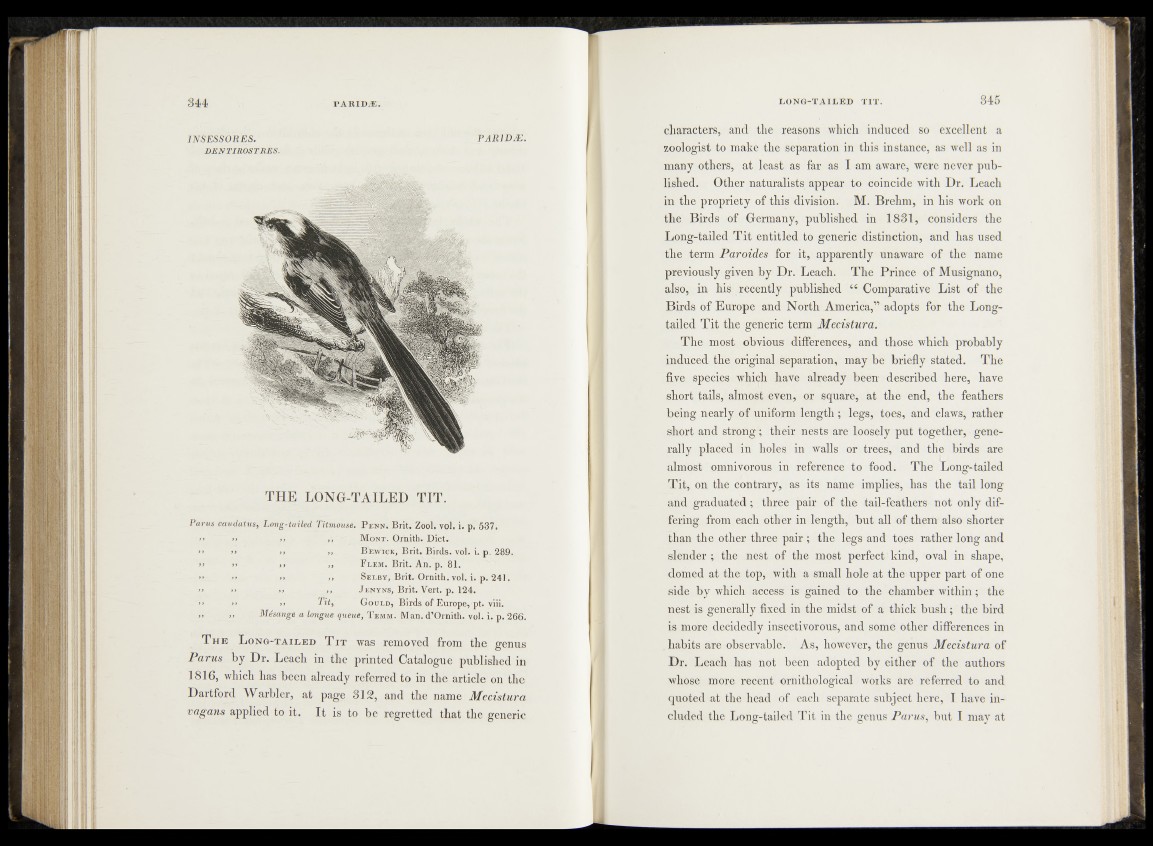
344
INSESSORES.
DENTIROSTRES.
M Ê Ê m
mm
PAR1DÆ.
HKH f I I1
TH E LONG-TAILED T IT .
Partis caudatus, Long-tailed Titmouse. P enn. Brit. Zool. vol. i. p. 537.
>> >> >> ,, M ont. Ornith. Diet.
»> >> » „ Bewick, Brit. Birds, vol. i. p. 289.
>> >> >> ,, Elem. Brit. An. p. 81.
>< ” >> ,, Selby, Brit. Ornith. vol. i. p. 241.
>> >> >, ,, J enyns, Brit. Vert. p. 124.
” >> >> Tit, Gould, Birds of Europe, pt. viii.
>> ” Mésange a longue queue, Temm. Man. d’Ornith. vol. i. p. 266.
T he Long-tailed T it was removed from the genus
Parus by Dr. Leach in the printed Catalogue published in
1816, which has been already referred to in the article on the
Dartford Warbler, at page 812, and the name Mecistura
vagans applied to it. It is to be regretted that the generic
H ' !
L O N G -T A IL E D T IT . 345
characters, and the reasons which induced so excellent a
zoologist to make the separation in this instance, as well as in
many others, at least as far as I am aware, were never published.
Other naturalists appear to coincide with Dr. Leach
in the propriety of this division. M. Brehm, in his work on
the Birds of Germany, published in 1831, considers the
Long-tailed Tit entitled to generic distinction, and has used
the term Paroides for it, apparently unaware of the name
previously given by Dr. Leach. The Prince of Musignano,
also, in his recently published “ Comparative List of the
Birds of Europe and North America,” adopts for the Longtailed
Tit the generic term Mecistura.
The most obvious differences, and those which probably
induced the original separation, may be briefly stated. The
five species which have already been described here, have
short tails, almost even, or square, at the end, the feathers
being nearly of uniform length ; legs, toes, and claws, rather
short and strong; their nests are loosely put together, generally
placed in holes in walls or trees, and the birds are
almost omnivorous in reference to food. The Long-tailed
Tit, on the contrary, as its name implies, has the tail long
and graduated; three pair of the tail-feathers not only differing
from each other in length, but all of them also shorter
than the other three pair ; the legs and toes rather long and
slender ; the nest of the most perfect kind, oval in shape,
domed at the top, with a small hole at the upper part of one
side by which access is gained to the chamber within; the
nest is generally fixed in the midst of a thick bush; the bird
is more decidedly insectivorous, and some other differences in
habits are observable. As, however, the genus Mecistura of
Dr. Leach has not been adopted by either of the authors
whose more recent ornithological woiks are referred to and
quoted at the head of each separate subject here, I have included
the Long-tailed Tit in the genus Parus, but I may at